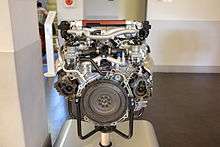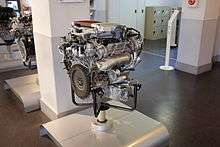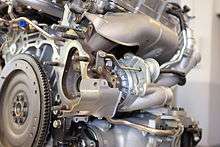Nissan VR engine
| Nissan VR engine | |
|---|---|
|
| |
| Overview | |
| Manufacturer | Nissan |
| Production | 2007–present |
| Combustion chamber | |
| Configuration | 60° V6 |
| Displacement |
3.0 L (2,997 cc) 3.8 L (3,799 cc) |
| Cylinder block alloy | Aluminum |
| Cylinder head alloy | Aluminum |
| Valvetrain | DOHC |
| Combustion | |
| Turbocharger | Twin-turbo |
| Chronology | |
| Predecessor |
Nissan VQ engine RB26DETT |
The VR is a twin-turbo DOHC V6 automobile engine from Nissan with displacements varying from 3.0 L to 3.8 L. An evolution of the widely successful VQ series, it draws on developments from the VRH JGTC and Nissan R390 GT1 Le Mans racing engines.
DDTT series
VR30DDTT
Announced by Infiniti on December 15, 2015 the VR30DDTT[1] will be first available in the Infiniti Q50 sedan and will come in a 300 hp and 400 hp version.[2]
Features:[3]
- Aluminium block with arc sprayed mirror coating to cylinder bores
- Aluminium cylinder head with integrated exhaust manifold
- Lightweight resin intake and lower oil pan
- Compact twin direct-mount turbos with electronic wastegate actuator
- Twin water-to-air charge coolers with one (300hp)/two (400hp) water pumps
- Electronically controlled variable displacement oil pump
- Intake: electronic variable Valve Timing Control (VTC)
- Exhaust: hydraulic continuously variable VTC
Applications:
- 2016 Infiniti Q50
- 2017 Infiniti Q60
Production
Production of the VR30DDTT engine began in 2016 at the powertrain plant in Iwaki, Fukushima, Japan.[4][5][6]
DETT series




VR38DETT
Designated the VR38DETT by Nissan, the engine is currently used in the 2007–present Nissan GT-R[7] and the limited production Nissan Juke-R.
The VR38DETT features 24 valves controlled by dual overhead camshafts (a total of 4 cams for both overheads) with variable valve timing (intake only). The block is cast aluminum with 0.15 mm (0.006 in) plasma-sprayed cylinder liner bores. This coating provides a hard protective layer for the piston rings to slide on as the piston moves up and down during their cycles. The turbine housings for the two IHI turbochargers are integrated into the exhaust manifolds to decrease weight and bolster vehicle balance. The engine also features a pressurized lubrication system controlled thermostatically. The VR38DETT is equipped with a feedback control system that changes air fuel ratio depending on the engine load which has a significant effect on reducing the fuel consumption.[8]

Fully equipped with the first set of catalytic converters, turbos, all of the engine driven accessories, front differential assembly, and turbo outlet pipes, the engine weighs 608 lb (276 kg).[9]
Other pertinent features of the VR38DETT include:
- Continuously variable valve timing control system (CVTCS) on intake valves
- Aluminum cylinder block with high-endurance/low-friction plasma-sprayed bores
- Iridium-tipped spark plugs
- Electronic drive-by-wire throttle
- Pressurized lubrication system with thermostatically controlled cooling and magnesium oil sump
- Fully symmetrical dual intake and low back-pressure exhaust system
- Secondary air intake system to rapidly heat catalysts to peak cleaning efficiency
- 50 State LEV2/ULEV
Applications:
- 2008–2011 Nissan GT-R CBA-R35, 480 HP
- 2012–present Nissan GT-R DBA-R35, 530-550 HP
- 2014–present Nissan GT-R Nismo, 600 HP
- 2012–present Nissan Juke-R (limited production run)
- 2014 Infiniti Q50 Eau Rouge Prototype, 560 HP
Racing:
- 2012–present Nissan GT-R Nismo GT3, 500 HP
- 2014–present Renault R.S. 01 race concept, 500+ HP [10]
VR38DETT NISMO Engine Tuning Menu Concept (2016)
It is a version of VR38DETT engine used in Nissan GT-R, with GT3-spec cam shaft, connecting rod and connecting rod bolt, intercooler, intercooler piping, turbocharger; NISMO 1st and 2nd catalyzers, titanium muffler.
The engine was unveiled in 2016 Tokyo Auto Salon.[11][12]
Production
The VR38DETT is hand assembled in a special clean-room environment at Nissan's Tochigi facility by specially trained technicians.[13]
Engine reference
| Engine code | Vehicle | Year | Displacement (Bore x Stroke) | Weight | C.R. | Max. power@rpm | Max. torque@rpm | Features |
|---|---|---|---|---|---|---|---|---|
| VR38DETT | Nissan GT-R | 2007–current | 3,799 cc (3.8 L; 231.8 cu in) (95.5 mm × 88.4 mm (3.76 in × 3.48 in)) | approx.600 lb (272.16 kg) | 9.0:1 | approx. 480 PS (353 kW; 473 hp) - 550 PS (405 kW; 542 hp)@6400 600 PS (441 kW)@6800 (NISMO) | 588 N·m (434 lbf·ft) - 652 N·m (481 lbf·ft)@3200-6000 | DOHC per bank Variable inlet cam phasing Twin Turbo |
| VR30DDTT | Infiniti Q50 | 2016–current | 2,997 cc (3.0 L; 182.9 cu in) (86.0 mm × 86.0 mm (3.39 in × 3.39 in)) | approx.429.5 lb (194.82 kg) | 10.3:1 | approx. 405 PS (298 kW; 399 hp)@6400 (High Output) 304 PS (224 kW; 300 hp)@6400 (Standard Output) | 475 N·m (350 lbf·ft)@1600-5200 (High output) 400 N·m (295 lbf·ft)@1600-5200 (standard output) | High pressure multi-split direct injection DOHC per bank Variable inlet and outlet cam phasing Twin Turbo |
See also
References
- ↑ 2016 Infiniti Q50 3.0t spec sheet
- ↑ "Infiniti announces new 3.0-liter V6 twin-turbo engine – the most advanced V6 ever offered by Infiniti". Nissan Online Newsroom. Retrieved 2015-12-16.
- ↑ "Infiniti VR 3.0-liter V6 Twin-Turbo Specifications". Infiniti.
- ↑ "3.0-liter V6 twin-turbo engine: the most advanced V6 for Infiniti".
- ↑ "インフィニティモデルに新型3.0リッターV6ツインターボエンジンを搭載".
- ↑ "Production of Infiniti's 'VR30' twin turbo 3.0-liter V6 engine begins in Japan".
- ↑ "日産:NISSAN GT-R [ GT-R ] スポーツ&スペシャリティ/SUV Webカタログ ホーム". .nissan.co.jp. 2007-10-24. Retrieved 2010-03-26.
- ↑ JDM Spec Engines - Nissan VR38DETT Engine
- ↑ "VR38DETT engine weight | 2009 Nissan GT-R". 2009gtr.com. 2008-02-28. Retrieved 2010-03-26.
- ↑
- ↑ 「東京オートサロン2016」出展概要を発表
- ↑ مجلة أفكار العربية : Nissan GT-R Nismo VR38DETT Engine Tuning Menu Concept - Tokyo Auto Salon 2016
- ↑ Where Are Nissan Cars Built? A Nissan Car FAQ